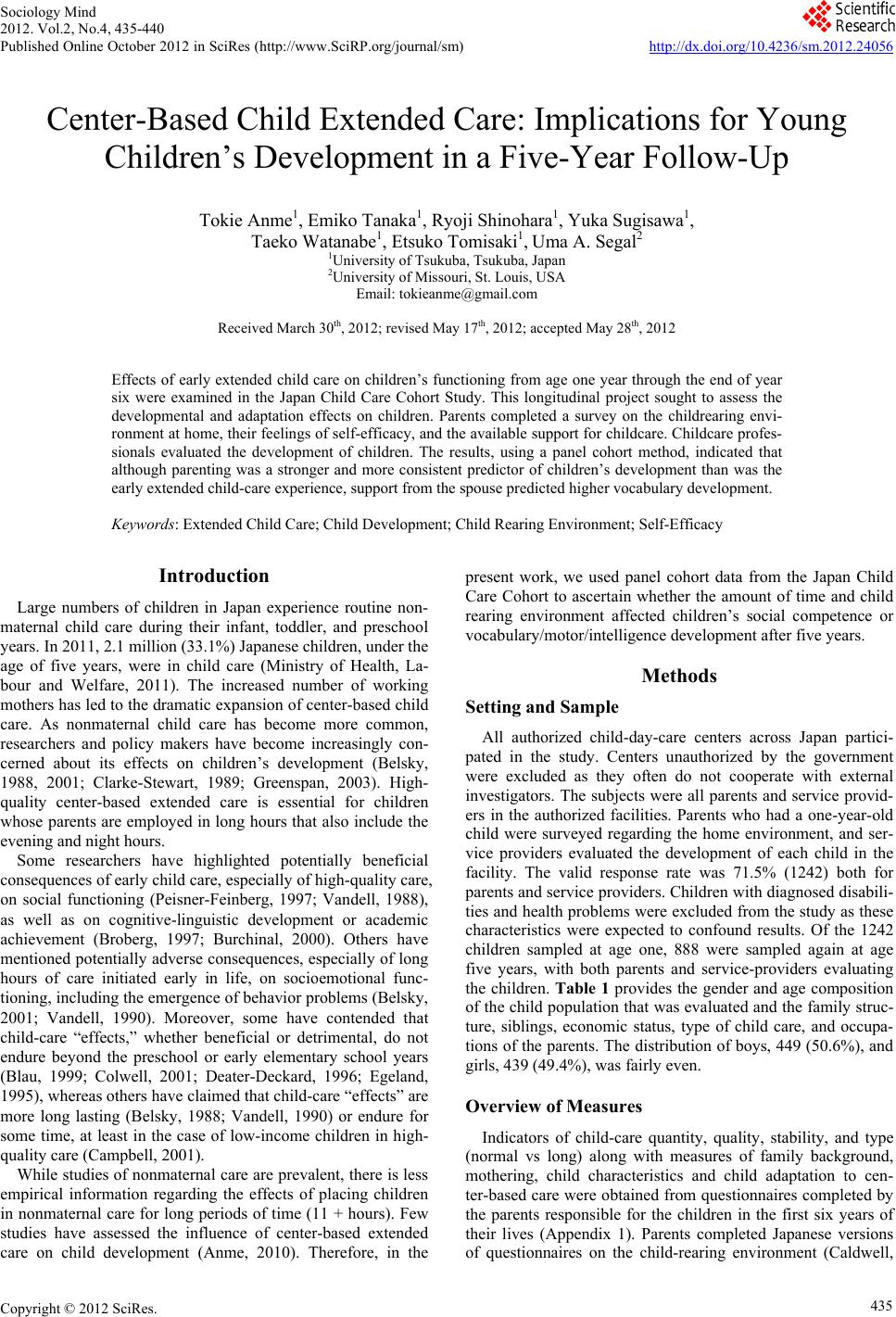
Sociology Mind
2012. Vol.2, No.4, 435-440
Published Online October 2012 in SciRes (http://www.SciRP.org/journal/sm) http://dx.doi.org/10.4236/sm.2012.24056
Copyright © 2012 SciRes. 435
Center-Based Child Extended Care: Implications for Young
Children’s Development in a Five-Year Follow-Up
Tokie Anme1, Emiko Tanaka1, Ryoji Shinohara1, Yuka Sugisawa1,
Taeko Watanabe1, Etsuko Tomisaki1, Uma A. Segal2
1University of Tsukuba, Tsukuba, Japan
2University of Missouri, St. Louis, USA
Email: tokieanme@gmail.com
Received March 30th, 2012; revised May 17th, 2012; accepted May 28th, 2012
Effects of early extended child care on children’s functioning from age one year through the end of year
six were examined in the Japan Child Care Cohort Study. This longitudinal project sought to assess the
developmental and adaptation effects on children. Parents completed a survey on the childrearing envi-
ronment at home, their feelings of self-efficacy, and the available support for childcare. Childcare profes-
sionals evaluated the development of children. The results, using a panel cohort method, indicated that
although parenting was a stronger and more consistent predictor of children’s development than was the
early extended child-care experience, support from the spouse predicted higher vocabulary development.
Keywords: Extended Child Care; Child Development; Child Rearing Environment; Self-Efficacy
Introduction
Large numbers of children in Japan experience routine non-
maternal child care during their infant, toddler, and preschool
years. In 2011, 2.1 million (33.1%) Japanese children, under the
age of five years, were in child care (Ministry of Health, La-
bour and Welfare, 2011). The increased number of working
mothers has led to the dramatic expansion of center-based child
care. As nonmaternal child care has become more common,
researchers and policy makers have become increasingly con-
cerned about its effects on children’s development (Belsky,
1988, 2001; Clarke-Stewart, 1989; Greenspan, 2003). High-
quality center-based extended care is essential for children
whose parents are employed in long hours that also include the
evening and night hours.
Some researchers have highlighted potentially beneficial
consequences of early child care, especially of high-quality care,
on social functioning (Peisner-Feinberg, 1997; Vandell, 1988),
as well as on cognitive-linguistic development or academic
achievement (Broberg, 1997; Burchinal, 2000). Others have
mentioned potentially adverse consequences, especially of long
hours of care initiated early in life, on socioemotional func-
tioning, including the emergence of behavior problems (Belsky,
2001; Vandell, 1990). Moreover, some have contended that
child-care “effects,” whether beneficial or detrimental, do not
endure beyond the preschool or early elementary school years
(Blau, 1999; Colwell, 2001; Deater-Deckard, 1996; Egeland,
1995), whereas others have claimed that child-care “effects” are
more long lasting (Belsky, 1988; Vandell, 1990) or endure for
some time, at least in the case of low-income children in high-
quality care (Campbell, 2001).
While studies of nonmaternal care are prevalent, there is less
empirical information regarding the effects of placing children
in nonmaternal care for long periods of time (11 + hours). Few
studies have assessed the influence of center-based extended
care on child development (Anme, 2010). Therefore, in the
present work, we used panel cohort data from the Japan Child
Care Cohort to ascertain whether the amount of time and child
rearing environment affected children’s social competence or
vocabulary/motor/intelligence development after five years.
Methods
Setting an d S am pl e
All authorized child-day-care centers across Japan partici-
pated in the study. Centers unauthorized by the government
were excluded as they often do not cooperate with external
investigators. The subjects were all parents and service provid-
ers in the authorized facilities. Parents who had a one-year-old
child were surveyed regarding the home environment, and ser-
vice providers evaluated the development of each child in the
facility. The valid response rate was 71.5% (1242) both for
parents and service providers. Children with diagnosed disabili-
ties and health problems were excluded from the study as these
characteristics were expected to confound results. Of the 1242
children sampled at age one, 888 were sampled again at age
five years, with both parents and service-providers evaluating
the children. Table 1 provides the gender and age composition
of the child population that was evaluated and the family struc-
ture, siblings, economic status, type of child care, and occupa-
tions of the parents. The distribution of boys, 449 (50.6%), and
girls, 439 (49.4%), was fairly even.
Overview of Measures
Indicators of child-care quantity, quality, stability, and type
(normal vs long) along with measures of family background,
mothering, child characteristics and child adaptation to cen-
ter-based care were obtained from questionnaires completed by
the parents responsible for the children in the first six years of
their lives (Appendix 1). Parents completed Japanese versions
of questionnaires on the child-rearing environment (Caldwell,